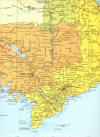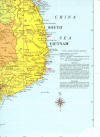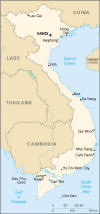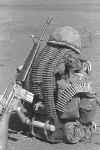Tim
O'Brien
American
Published 1990
Introduction
Here we begin a look at a different genre -- the novel. And The Things They Carried is a great introduction to this genre because it will seem very familiar after short stories. It's constructed from interconnected stories that cumulatively pack the emotional punch and sustenance of a novel.
We'll be looking at the title rather closely: one of the "things" we'll be
working is to figure out just what this novel is "about" -- and it
isn't just "about" the war.
The Times
Political
Given the contentious nature of American involvement in the war, it's especially important to understand the political background surrounding the war chapters.
In the 50s, the lines between good and evil were clear: America=democracy=good -- Russia/China= communism=evil. The Cold War was at the sub-zero mark, with kids practicing the desk protection system (ducking under their desks for protection when they saw the flash of an explosion), people building bomb shelters in their back yards, and by the early 60s, enemy nukes on our shores (Cuba). This led to an undercurrent of malaise disturbing the seemingly placid facade of the 50s: fear is a powerful drug, often rendering things like reason and morality powerless -- and for all the country-clubs and drive-ins and days at the beach with Biff and Barb, we were very fearful in the fifties.
When Vietnam seemed headed towards communism in the 50s, American political and military leaders grew worried that all of Southeast Asia would gradually succumb to the lure of communism (the Domino Theory). This would mean that the subcontinent of Asia would be, in the "us v. them" vernacular of the time, "lost." While the Geneva Accord (1956) stipulated that free elections were to be held throughout Vietnam to determine its fate, the leader of South Vietnam, Diem, blocked the elections, with the support of the US (both Diem and the US knew that in free elections, the Vietnamese people would vote for unification under a communist rule). The North Vietnamese, tired of waiting for a political solution to the country's division, opted for a military one.
Two years earlier, in 1954 (after the French lost their war [called the Indochina War] in a decisive defeat in Dien Bien Phu), the CIA had begun funding covert operations against North Vietnam (see Gulf of Tonkin above for how we became more directly involved). Since the US had just defended (and tentatively won) a war to defend an Asian country from the evil of communism (South Korea), we were primed to act again to support "national security interests." Of course, one nation's "national security" is another's "war of independence," and we found out rather quickly that not everyone in Vietnam was ready to welcome the smiling face of American democracy with open arms. Our response to this equivocation by Vietnam was simple: as one US military official said regarding a Vietnamese hamlet that had been reduced to charred, smoking ruins by a napalm strike: "we had to destroy the village in order to save it."
The narrator's induction and service in the army occur in 1968, a year which marks a turning point in American politics. Four major events occurred that year: the Tet Offensive; the assassination of Martin Luther King; the assassination of Robert Kennedy; and the Democratic Convention in Chicago. The Tet Offensive, attacks by the North Vietnamese throughout South Vietnam (including the American Embassy in Saigon) during the Vietnamese New Year (Tet) celebrations, weakened support for the war among citizens at home. Our officials had been framing the war as a "wrap up" operation with the enemy on the run. When film of the attacks, including summary executions (see below) and US soldiers cowering behind walls within the embassy in Saigon, was beamed into living rooms in full color, many Americans finally began to see that there was a disjunct between what the military said about the war, and what was actually occurring on the ground. And this interpretation is not just idle peacenik speculation: as the publication of the Pentagon Papers revealed in 1971 and as then Secretary of War Robert McNamara has more recently revealed in a self-serving mea culpa memoir (In Retrospect, 1996), much of what the government reported to the American people about the war were, to be blunt, lies.
South Vietnamese National Police Chief Brig Gen. Nguyen Ngoc Loan executes a Viet Cong prisoner in Saigon at the height of Tet (1968). This photo and the film of the execution considerably weakened American support for the war. |
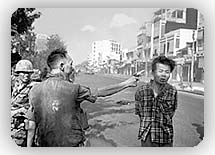 |
Still, there was the hope of "doveish" political leaders, like Bobby Kennedy, who had changed from a "hawkish" view of the war in his brother's administration, to a more reconciliatory approach towards the conflict. Sirhan Bishara Sirhan ended this faint ray of hope with a handgun in a Los Angeles hotel.
| Robert Kennedy being comforted by a busboy. |
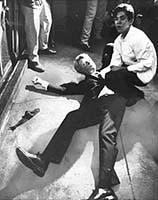 |
The cumulative effect of these events meant that O'Brien and, of course, the nation faced a society in flux, a time when accepted political values and beliefs were being challenged; we had moved from the paternalism of Eisenhower to the "what you can do for your country" of Kennedy, but had yet to agree on what to "do."
The aftermath of the war, which help shape the narrator's thoughts, included a curtailment of the enlightened ideals of President's Johnson's "Great Society" (circa 1964-68) -- freedom from poverty, illiteracy, etc. -- which were compromised by the costs of the war effort. Money that could/should have been used to counter social ills was spent financing the war (final cost, 1 trillion dollars). And of course, the political backlash against military actions and fear of causalities has changed America's foreign and military policy. We're more wary of incursions into other territories for fear of body bags (notice how quickly we exited Somalia after "Black Hawk Down"), and rely now on "Smart Bombs" and other ordnance instead of soldiers on the ground. Unfortunately, one of the main "lessons" our government has learned from the war is to control information and to spread misinformation (no more reporters tagging along in helicopters to send compromising footage back home to the folks in Peoria).
Social/Cultural
The events in the novel occur against a background of liberation: Women's Rights, Civil Rights, youth rights . . . in other words, a time of change. The various constituencies agitating for change were responding to the 50s (cf. Modernist's response to the repression of the 19th century), a time of drive-ins, stay-at-home moms, and a conservative government embodied by Dwight Eisenhower. In the 50s, if you were different, you were a beatnik and your opinions were marginalized. If you protested too strongly, you could find yourself labeled a communist (remember, the temperature of the Cold War was around zero at this time), and find yourself out of a job (McCarthyism). This was a time when God, Guns and Guts ruled the land: the words "under God" were inserted in the Pledge of Allegiance in the 50s, and Westerns (white man with a revolver and courage saves the world) were all the rage. But the war years of the novel takes place in the interim period, when America was making the change from Leave it to Beaver to Laugh-In (which was, if you aren't familiar with it, a politicized Saturday Night Live).
Yet while many agitated for change, there were some -- who Nixon mistakenly labeled "the silent majority" -- who wanted things to remain the same. Think of it as Levitt town v. Haight Asbury -- hard hats v. egg heads (note that the segregationist George Wallace was a candidate for president in 1968). And that last contrast gets at an essential part of the debate of the war -- and of American culture in general: anti-intellectualism. Consider the loci of the protests: college campuses. For those in favor of the war, the problem with the protesters was that they thought too much. Joseph E. Sintoni, a soldier who later died in the war, wrote to his fiancée' "The press, the television screen, the magazines are filled with the images of young men burning their draft cards to demonstrate their courage. Their rejection is of the ancient law that a male fights to protect his own people and his own land" (252). He adds "We must do the job God set down for us. It's up to every American to fight for the freedom we hold so dear. We must instruct the young in the ways of these great United States"(252). Joseph represents the Levitt town approach to war -- God, Guns and Guts. The ideals of the Haight can be found in Mark Rudd's open letter to his college president, Grayson Kirk, of Columbia University: "We do have a vision of the way things could be: how the tremendous resources of our economy could be used to eliminate want, how people in other countries could be free from your domination, how a university could produce knowledge for progress, not waste, consumption, and destruction . . . . how men could be free to keep what they produce, to enjoy peaceful lives, to create" (248). These two competing visions were at the root of American views of the war and its causes -- and the catalyst for much of the internal strife.
Of course, I'm painting a rather rigid dichotomy. Many Americans rejected Sintoni's jingoism just as they objected to Rudd's idealism. And there were many who, I'm sure, really could care less as long as the Dodgers still played and the Milwaukee's' Best still flowed. Sad, isn't it, how some things never change.
The Arts
Two broad movements form the aesthetic background to this novel: the surrealism of the 60s, and the post-modernism of contemporary literature. Surrealism adds a hallucinatory quality to a work of fiction, the prose equivalent of the swirling washes of color and stream of consciousness imagery of the psychedelic posters (and those mind-bending Grateful Dead and Allman Brother's album covers) from the 60s and 70s. Yet the surrealism on display in the novel isn't merely a period piece; it's our old friend the unconscious, the Id, showing up again to topple the existing order. It's a method of conveying the often tortured and tortuous mental landscape of a mind in conflict with itself.
The Post-modern aspect of the novel appears in its self-referential quality -- more particularly labeled metafiction, which means fiction about the nature of fiction itself. While this has a long history (Tom Jones by Henry Fielding is an 18th century example), the emphasis on form in Modern literature led to an exposure of the same (i.e. illustrating the artifice of fiction) in much of contemporary literature. Literary movements usually move in reactionary cycles: authors grow frustrated with established conventions and have to reinvent the art of literature to fit the new age. Thus, in Things They Carry, you'll find a writer who ironically discusses the act of writing itself: he both tells a great story -- and tells us he's telling a great story. And watch for references to the "author" himself -- and be aware that post-modern writers love to play around with the idea of the narrator/author.
Shakespear's "Shall I Compare Thee to a Summer's Day" is relevant here and will be discussed in class
XVIII (765 in Textbook
Shall I compare thee to a summer's day?
Thou art more lovely and more temperate:
Rough winds do shake the darling buds of May,
And summer's lease hath all too short a date:
Sometime too hot the eye of heaven shines,
And often is his gold complexion dimm'd,
And every fair from fair sometime declines,
By chance, or nature's changing course untrimm'd:
But thy eternal summer shall not fade,
Nor lose possession of that fair thou ow'st,
Nor shall death brag thou wander'st in his shade,
When in eternal lines to time thou grow'st,
So long as men can breathe, or eyes can see,
So long lives this, and this gives life to thee.
The Life
Tim O'Brien grew up in small-town Minnesota (where he experienced first-hand the clash of small-town morals with the outside world). He credits his mother, a first grade teacher, with investing in him the importance of paying attention to details when writing. Attending a state college in Minnesota, he majored in Political Science and was elected the student body president. Upon graduation, he was drafted in August of 1968, and served seven months as a radio operator in Chu Lai. Wounded twice, he spent the last five months of his Vietnam tour as a clerk, away from combat duty. After his tour of duty, he attended graduate school at Harvard, and completed (but did not defend) his dissertation, and began writing for the Washington Post in 1972 (Kaplan 1-9). His first book, If I Die in a Combat Zone, a memoir of his service in Vietnam, established him as a writer of talent, and his novel Going After Cacciato (which is also set in Vietnam), after winning the National Book Award in 1979, vaulted him into the upper ranks of American authors.
He has a very generous spirit as a writer, regularly appearing at workshops (my office mate worked with him years ago and found him refreshingly unpretentious and "down to earth") and giving copious interviews on his craft. On his penchant for writing about Vietnam, he noted "[my] concerns as a human being and . . . as an artist have at some point intersected in Vietnam -- not just in the physical place, but in the spiritual and moral terrain of Vietnam" (qt. in Kaplan 4-5). And as this novel makes clear, this is a terrain well worth exploring.
My Lai Massacre
Another good My Lai site Long and detailed article on the massacre For a contemporary version of My Lai, see the following http://www.rotten.com/library/crime/prison/abu-ghraib/ |
Citizen soldiers exercising their free speech rights (click to enlarge) |
Remember when O'Brien talks about the beauty of war? (click to enlarge) |
|
Connections between Vietnam and Iraq? See Ron Kovic's essay published on Truthdig. Note: it's a partisan view.
Radio Essays
- Interesting audio essay on how facts can be slippery: Radiolab http://www.radiolab.org/2012/sep/24
- Audio essay on how easily people can be mislead by fiction . . . sound familiar? Radiolab http://www.radiolab.org/2008/mar/24
Vietnam
Glossary
In this novel you'll find several military acronyms,
topical references, etc., that may need a bit of explaining. Hence, a
glossary. Color Coded -- blue = political terms, green = military terms and abbreviations
Let's clarify three things, right off the bat.
Vietnam: Area/country in southeast Asia with an
independent language, culture, and government. Partitioned into North and
South Vietnam in 1954 in response to the western fear of communism, the two
countries were rejoined in 1976 after the fall of the South Vietnamese
government. During the war years, the country was bisected by the DMZ
(Demilitarized Zone).
North Vietnam: The communist controlled area of Vietnam
-- they wanted to unite the country under one rule. South Vietnam's and,
because of the Southeast Asia Treaty Organization (SEATO), our enemy.
South Vietnam: The non-communist, nominally democratic
(but really autocratic) area of Vietnam. Our ally due to SEATO which
stated that any member which comes under attack will enjoin all members in its
defense. South Vietnam and America were members: North Vietnam was not.
Map of
Vietnam listing major battle areas. Since this is a modern map, what was
Saigon during the war is listed as Ho Chi Minh city.
AK-47: Standard issue rifle used by North
Vietnamese. Cheap, reliable, deadly. Now a designer weapon for drug
dealers.
America: love it or
leave it: phrase
adopted by the great unthinking class as a response to protests against the
war. It stifles dissent by suggesting that "you're either with
merica', or you're with the terrorists." Oops, wrong war -- but same
idea.
ARVN Army of the Republic of Vietnam.
Considered poor fighters by US service men.
Bao Dai: The "playboy emperor."
Last emperor of Vietnam, courted and assisted by both communist and American
regimes because "the people" accepted him as a sovereign ruler.
An opportunist, and for that reason, a survivor.
Bouncing betty: a type of land mine. After a soldier,
civilian, or water buffalo would step upon it, a little rocket/bomb would shoot
up that exploded at about waist height. Usually deployed by the North
Vietnamese.
Claymore: rectangular mine set off by remote
control. It would send a shower of lead in a triangular killing
field. Usually deployed by Americans. See picture below

Diem, Ngo Dinh: Autocratic ruler of South Vietnam from
1955-63. Corrupt, a Roman Catholic in a Buddhist country, he was propped
up by American officials because of his hard line stance against
communism. Assassinated by his own military in a 1963 coup.
domino theory: argument used by American political
leaders to support a war against communism. They believed that if one
country fell to communism, then others around it would fall as well (like a
line of dominoes). What they never seemed to address was why communism
would prove so attractive. I mean, it's not a virus or anything, it's
merely a political system.
Gook: US military slang for a Vietnamese
person.
Gulf of Tonkin: located in North Vietnam (see map
above). Important because US military and intelligence reported that a
Navy destroyer, the USS Maddox, was attacked by North Vietnamese gunboats in
1964, which lead to a resolution to increase military presence and its role in
South Vietnam. It is now generally accepted that the attack did not take
place and some feel that the military and intelligence agencies perpetuated a
hoax to prompt deeper US involvement in the war.
Hawks and doves: shorthand to describe support for
(hawks) or opposition to (doves) the war. Prominent hawks from the era
include John F. Kennedy (though he was there before the term really was bandied
about), Barry Goldwater, Richard Nixon, and Henry Kissinger. The main dove
mentioned in the novel is Senator and Democratic Presidential Nominee Eugene
McCarthy.
Ho Chi Minh: The political and spiritual (in an
agnostic sense) leader of North Vietnam. In the 1950s, after reading the
Declaration of Independence, he approached American officials in France (where
he was educated) and asked them for his help in overthrowing the French
colonial powers. We refused due to treaty alliances and because of cheap rubber
(Vietnam's primary export) and Minh then turned to Russia and China for support.

R&R: Rest and relaxation. A vacation
from the battlefield typically involving a trip (or trips) to a brothel,
drinking, and, if such was your preference, drugs. Sleep and good food as
well. In other words, creature comforts for 19 year old males.
klicks: slang for kilometers
Eugene McCarthy: presidential candidate in 1968 elections
who was against the war. To support him meant you too were against the
war.
M-16: Standard issue rifle used by the US and
South Vietnamese. It was expensive, semi-reliable, and deadly.
Because of its toy-like look, it has not become a designer weapon for drug
dealers.
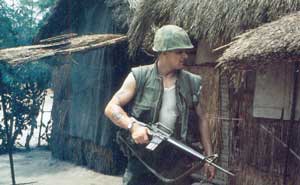
From http://s88.photobucket.com/albums/k188/kampat/
mortar: tube like cannon, easily hidden,
transported, and operated. A favorite of the Viet Cong.
napalm: bombs filled with jelled gasoline which
ignites on contact with the air. Usually dropped from jets which resulted
in a streak of fire (momentum of bomb would spread flame).
tracer rounds: bullets treated with a chemical to make
them flammable on contact. If fired at night would leave a streak of
light -- handy for aiming, though it also made a great target.
Sterno: metal cans of jelled petroleum. Pop the top, instant stove.
Tran Hung Dao: Vietnamese general who repelled Mongol
invasions in the 13C. (roughly equivalent to George Washington in America
-- i.e. military founding father).
Tot Dong: field where the Vietnamese defeated the
Chinese in 1426, leading to their independence (think Bunker Hill).
VC: short for Viet Cong, the communist guerilla fighters who
lived in South Vietnam.
Walked point: walking at the head of line of soldiers in a
patrol. Dangerous because you would be the first person to encounter a
landmine, sniper, or ambush.
Willie Peter: Short for White Phosphorous, a incendiary explosive material.
It's important to note that, contrary to the stereotype of Vietnam veterans as
seething caldrons of repressed anger ready to explode at a moment's notice,
most veterans readjusted to civilian life as well as veterans of previous wars.
Yet serving in Vietnam was a different experience from previous war. For
one thing, soldiers were not assigned for the duration of the conflict:
soldiers only had to serve 365 days of combat duty, and then were rotated out
of country (as opposed to "in-country"). This abbreviated
service meant that soldiers did not have the opportunity to form the lasting
attachments to others in their units that would help provide emotional support
-- and a sense of continuity. Additionally, the alien country and culture
lead to a disorienting feeling, as did the nature of guerilla warfare (where
your enemy could be the smiling woman selling you mangos). And of course,
some soldiers faced a hostile reception upon returning home. These all
contributed to the post traumatic stress syndrome suffered by some
veterans. This wasn't a new disease -- it's simply a label for an
affliction that has affected soldiers for centuries upon their return to
civilian life.
These are, literally, the things a foot soldier would carry. The rifle leaning against the backpack is an M16, manufactured by Colt arms (of six-gun taming the West fame). The belt of ammo is for an M60 machine gun -- the kind of gun Henry Dobbins (a character you're soon to meet) carries. |
|
|
Questions
to Mull Over As You Read
"Things They Carried"
- Consider the following sentences "It was't cruelty, just
stage presence. They were actors" (20). Why? Why characterize the
soldiers as "actors"? And what effect does this have on their
actions -- and our understanding of them?
- Why the accumulation of specific weight and specific detail in the
lists of the things they carry? What effect does it have on the reader?
And how do they contrast with the other paragraphs in the story?
- What is LTV. Cross crying about (17)? What is this story really
"about"?
- Why is this the first story/chapter in the novel? How does it
connect to the other stories?
"Spin"
- How does this story function as a foreshadowing for the rest of
the novel? Pick out pages/details and explain.
"On the Rainy River"
- Why does the narrator work in a pig slaughter house? Does it
foreshadow his experiences in Vietnam in some way? See, especially, page
42.
- Why is Tim so upset with the people that support the war?
- What is "courage" to the narrator? Given the story, do
you agree or disagree with him?
- What is Elroy Berdhal's function in the story? Why not just have
O'Brien standing on a windswept prominence, debating whether he should go
to Canada or not? What does Berdhal represent?
General questions
- Consider the relevance of the following quote to the entire story:
"Absolute occurrence is irrelevant. A thing may happen and be a total
lie, another thing may not happen and be truer than the truth" (83).
How does this relate to 1) the story/novel itself; 2) the nature of story
telling in general?
- Which "True" is he talking about in the title of the
story/chapter ("How to Tell a True War Story) -- the
"happening-truth" or the "story-truth" ("Good
Form" 179)? How can you tell -- or not tell? Does O'Brien feel this
distinction is important? Why or why not?
- Trace the transformation of Mary Anne "Sweetheart:" she
changes from ____ to _____. What could she symbolize? Why/how?
- What "Courage" is referred to in "Speaking of
Courage"?
- How does the metaphor of the "shit field" resonate
throughout the story. Why not, for example, a regular muddy field?
- How is imagination something positive in the book? (consider, for
example, "Lives of the Dead," "Good Form"). How is it
negative ("Thing They Carried," "Ghost Soldiers" --
other stories?)? What's the point?
- Why does Bowker taste the water at the end of "Speaking of
Courage" (173)?
- What can the narrator O'Brien do that Bowker cannot? How can this
ability save the narrator? (Consider "Notes")
- How does the narrator change? From what to what? (Take this in
stages -- use particular chapters to trace this change) What stories show
this? Where in those stories? Does your opinion of the narrator change?
- What's Linda doing in the novel? How does she
or her story connect with other themes? If she and that chapter was not in
the novel, how would it change? Another way of looking at this is why does
"Lives of the Dead" conclude the novel?
- In an interview, O'Brien stated "If there
is a theme to the whole book it has to do with the fact that stories can
save our lives" (qtd. in Coffey 202). So, where's the theme? Point to
at least three quotes that prove this.
Works Cited
Kaplan, Steven. Understanding
Tim O'Brien. Columbia, South Carolina: U of South Carolina, 1995.
Rudd, Mark. "We, the Young
People." Ordinary Americans: U.S. History Through the Eyes of
Everyday People. Ed. Linda R. Monk. Alexandria, VA: Close Up Publishing,
1994.
248-49.
Sintoni, Joseph. "Our
Country, Right or Wrong." Ordinary Americans: U.S. History Through the
Eyes of Everyday People. Ed. Linda R. Monk. Alexandria, VA: Close Up Publishing,
1994. 252.
Image credits
m16 picture mike@entrinet.softnet.co.uk
© 2001 David Bordelon











